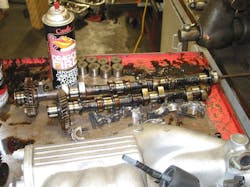Techs Helping Techs is turning 12 And it’s time for another roundup of useful tips and tricks courtesy of your fellow technician readers. While our writers share their expertise in every issue, it’s extra special when our readers share what they’ve learned from their days and nights working in the service bay. Thanks to all who shared their advice.
DON’T MIX THEM UP
Whenever you’re dealing with a flat tappet camshaft or OHC lifter buckets, during disassembly, be sure to keep all lifters organized and marked relative to their specific cam lobe locations. This is important for inspection and diagnosis, as well as if you intend to re-use the cam and lifters. While it should be obvious that you can’t mix flat tappet lifters or bucket lifters (roller lifters don’t have this issue and can be interchanged), some folks forget the importance of keeping flat-tappet lifters organized relative to the cam lobes if you intend to re-use the cam and lifters. Mixing up used lifters can result in accelerated cam lobe wear.
Russell Haslem
RTC Performance
MOMENTARY CLUNK IS NORMAL
We had a customer bring in a 2017 Buick Enclave, complaining that he heard a clunk/thump noise on acceleration, but it only happened once after each key cycle. Initially we thought this might be coming from the suspension or engine compartment. Actually, this was being caused by the second phase power-up self-test of the ABS. The self-test begins when the vehicle is driven faster than 9 mph and when the EBCM has not detected any traction control or vehicle stability concerns. This phase can be heard and felt by the driver. The system solenoids and ABS pump motor are commanded on and off to verify proper operation. This self-test noise is a normal action.
Brad Marvin
Countywide Service
BROKEN VALVE SPRING?
When servicing any Chevy or GMC vehicles (2014-present) equipped with a 4.3L, 5.3L or 6.2L engine, and the SES lamp lights up, accompanied by DTC P0106 and P0506, the cause may be a failed/broken valve spring. Remove the rocker covers and inspect the springs. If you find a broken valve spring, naturally you’ll want to replace it, but pay close attention first by finding out if the valve has dropped and possibly damaged the piston and/or the block. If the valve hasn’t caused any damage, replace the offending spring. But also inspect the intake manifold to see if a runner has collapsed, in which case you’ll need to also replace the intake manifold.
Harry Overland
Quaker Service
ECOBOOST EVAP VALVE
The Ford 2.7L Ecoboost twin-turbo GTDI engine, as you know, is very popular among several Ford vehicle models. They make decent power and torque (not as much as the 3.5L, but acceptable for most folks unless they’re doing a lot of towing). Each model year brings slight changes in any vehicle, but with respect to the 2015 2.7L, you may run into a MIL on with DTC P2450 stored in the PCM. If P2450 is the only DTC stored, take a look at the EVAP system. The fuel-tank-mounted EVAP blocking valve may be bad. You’ll likely need to remove the fuel tank to do this, and also disconnect the driveshaft. Be aware that the blocking valve part number differs between the standard size fuel tank and the 36-gallon extended range tank (standard tank takes P/N FL3Z-9F945-C; the larger tank takes JL3Z-9D333-D).
Bobby Young
Deval Auto
HONDA ENGINE RATTLE
If you’re dealing with a 2013-2015 Honda Crosstour equipped with a 3.5L engine (or any Honda engine featuring VCM (variable cylinder management) rocker arms, the customer may complain about a rattle noise and rough running. (The MIL may or may not be blinking when you inspect). Chances are very good that a VCM rocker arm pin is tapping against the adjacent rocker arm as it tries to lock the two arms together when trying to go into VCM. Or, the arms may be stuck together in the locked position (chances are the MIL will blink in this case). This may be intermittent, as the arms try to lock, lock or stay locked together during engine operation, which can make diagnosis difficult. Refer to the service manual for the procedure on VCM rocker arm test. Once you find the culprit, simply replace the stubborn rocker arm(s).
Ely Roberts
Grand Service Center
FORD 5.4 VCT
When dealing with a Ford 5.4L 3-valve V8 (2004-2005, as an example), the customer may comment about a rough idle and/or intermittent misfires. Of course, lots of areas could be the problem (fuel injectors, ignition, etc.), but the VCT (variable valve control) could be the issue. Even if there are no DTCs that direct you to the VCT, that system could still be the culprit. First off, before you delve into deep diagnostics, check the engine oil level and quality. Low oil level and/or contaminated oil could be the root cause that resulted in VCT issues. Is the engine making a noise or rattling? With the engine off, disconnect the VCT solenoid connector and then start the engine. If the noise goes away or changes, this indicates a VCT problem. If you suspect the VCT, connect IDS and check PIDs for both banks with the engine at normal temperature. It should be in closed loop. VCT advance error pitch should hover around zero degrees. (A variance of plus or minus 5 degrees is OK.) The pulse width modulation should be the same on both banks. In open loop, the system should be disabled. Even with sufficient oil in the sump, if oil pressure is insufficient, there may not be enough hydraulic pressure to work the VCT (indicating a bad oil pump or more likely sludge buildup restricting oil passages). Make sure the engine is at full temperature when you check oil pressure, and be sure to use a good pressure gauge when checking.
Mike Hallinger
Mike & Dale’s
CONFUSED COBALT
We recently worked on a 2010 Chevy Cobalt equipped with a 2.2L engine. The transmission was experiencing a hard shift going into third gear. A scan showed DTC P1810 (transmission control module cannot determine correct line pressure). Scan data showed that the transmission fluid pressure switch signal C (orange wire from the TCM to the transmission) was low (grounded when it should read high). We back-probed signal C (orange) and B (blue) with a multimeter on DC volts and monitored circuit voltage while moving the shifter. The orange wire should show battery voltage in Park and Drive. The blue wire should show battery voltage in Park and Reverse. At all other times, these circuits should be pulled low. In our case the signal C (orange) was pulled low all of the time. We unplugged the transmission connector and the circuit did not go high. We found the orange wire was shorted to ground next to the oil filter housing (very sharp edge here). We repaired the shorted wire and relocated the harness away from the oil filter housing. We cleared the codes, conducted a test drive and verified the repair.
James S. Hartley
Jim’s Mobile Diagnostic
About the Author
Mike Mavrigian
Motor Age Editor
Mike Mavrigian has written thousands of automotive technical magazine articles involving a variety of specialties, from engine building to wheel alignment, and has authored more than a dozen books that crisscross the automotive spectrum. Mike operates Birchwood Automotive, an Ohio shop that builds custom engines and performs vintage vehicle restorations. The shop also features a professional photo studio to document projects and to create images for articles and books.

